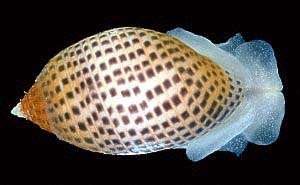
Pupa solidula
Linnaeus, 1758
Order: CEPHALASPIDEA
Superfamily: ACTEONOIDEA
Family: Acteonidae
DISTRIBUTION
Found throughout the tropical Indo-West Pacific. Burrows in sand.
PHOTO
Shell length: 20mm. Koumac, New Caledonia, October 1993. PHOTO: Bill Rudman.
The acteonids are some of the most primitive of the opisthobranchs, having a very "snail-like" appearance, with a prominent, heavily calcified shell, an operculum, and a relatively small colourless animal. Note the posterior flaps on the head, which form the "headshield" which give them the name "cephalaspid". The flaps overlap the front of the shell which protects the mantle cavity from being clogged with sand when the animal is burrowing. Despite their "primitive" body plan, they are in fact highly specialised, feeding on polychaete worms.
Pupa solidula has a spiral pattern of black spots and can be found with two other similarly coloured species, Pupa strigosa (Gould, 1859) and Japonacteon suturalis (A.Adams, 1855). Another species, very similar in shape and size, Pupa coccinata (Reeve, 1842a), differs in having orange-red spots. It is considered just a colour form of P. solidula by some authors.
See SEM photo of radula below.
References:
• Rudman,W.B., A study of the anatomy of Pupa and Maxacteon (Acteonidae, Opisthobranchia), with an account of the breeding cycle of Pupa kirki. Journal of Natural History, 1972: 603-619.
• Rudman,W.B., 1972. Structure and functioning of the gut in the Bullomorpha (Opisthobranchia). Part 2. Acteonidae. Journal of Natural History, 6: 311-324.
Rudman, W.B., 1998 (December 18) Pupa solidula Linnaeus, 1758. [In] Sea Slug Forum. Australian Museum, Sydney. Available from http://www.seaslugforum.net/find/pupasoli
Related messages
Radula of Pupa solidula
June 15, 2001
From: Bill Rudman

To accompany my comments on Japonacteon suturalis here is an SEM photo of the radula of Pupa solidula which is typical of the genus with 5-5 almost identical teeth in a halfrow. Each tooth has a long inner pointed cusp and a number of large pointed basal denticles.
PHOTO: SEM photo of radula. Plateau Karembé, near Koumac, New Caledonia, 20°38'S, 164°16'E, intertidal, mixed substrate, sand and coral blocks, 20 October 1993, 2 specimens, AM C200552. Photo: Alison Miller.
Best wishes,
Bill Rudman
